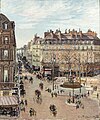Rue Saint-Honoré, dans l'après-midi. Effet de pluie

Rue Saint-Honoré, dans l'après-midi. Effet de pluie ("Rue Saint-Honoré in the Afternoon. Effect of Rain") is an 1897 oil painting by Camille Pissarro. The work was made towards the end of Pissarro's career, when he abandoned his experiments with Pointillism and returned to a looser Impressionist style. It is part of a series of works that Pissarro made in 1897-98 from a window of the , looking down across the edge of the place du Théâtre Français (now the ) and along the rue Saint-Honoré, portraying the people, carriages and buildings, the trees, fountains and streetlamps, in an early afternoon shower of rain. Other paintings in the series depict a similar scene in morning sunlight, or in the shadows of the evening. The painting measures 81 cm × 65 cm (32 in × 26 in).
The painting has been displayed at the Museo Thyssen-Bornemisza in Madrid since the museum opened in 1992. It had been bought by Baron Hans Heinrich Thyssen-Bornemisza at the Hahn Gallery in New York in 1976, from a US collector who bought it at the Knoedler Gallery in New York in 1952. In 1993, the baron sold it with the rest of his collection of 775 works to the Spanish state for US$350 million. A claim that the painting was Nazi looted art was dismissed by US courts in 2019 and 2020. However, in September 2021, the U.S. Supreme Court accepted certiorari to review that decision.
Provenance[]
The painting was bought from Pissarro by the German businessman Julius Cassirer in 1897, and it was inherited by his son Fritz Cassirer and then by Fritz's wife Lilly. She remarried, but in 1939, as a German Jew, she was forced to sell the painting to , an official of the , for the low price of RM 900 to secure an exit visa, shortly before the outbreak of the Second World War. The painting was sold at an auction in Berlin in 1943 for RM 95,000 and disappeared from public view. In 1958, a German court awarded Lilly Cassirer Neubauer compensation of DM 120,000, the fair market value for the work.
In 2005, Lilly's grandson Claude Cassirer and other heirs filed a claim to recover the painting. In January 2011 the Spanish government denied a request by the US ambassador to return the painting, and in 2015 a Spanish court ruled that the painting belonged to the museum. In April 2019 the United States District Court for the Central District of California ruled that the painting belongs to Fundación Colección Thyssen-Bornemisza, on the basis that the baron and then the museum did not know it was looted art when they bought it. While that decision was affirmed by the United States Court of Appeals for the Ninth Circuit in 2020, in September 2021, the U.S. Supreme Court accepted certiorari to review the Ninth Circuit's decision. The case was heard on January 18, 2022.[1]

1898 painting of the same scene in sun: La rue Saint-Honoré: effet de soleil, après-midi ("Rue Saint-Honoré, effect of sun, afternoon"), Nelson-Atkins Museum of Art

Adjacent view, Place du Théâtre Français: effet de pluie ("Place du Théâtre Français, effect of rain") 1898, Minneapolis Institute of Art
References[]
- ^ Sneed, Tierney. "Pissarro painting confiscated by Nazis at center of Supreme Court arguments". CNN. Retrieved 2022-01-25.
- Camille Pissarro, Rue Saint-Honoré in the Afternoon. Effect of Rain, Museo Nacional Thyssen-Bornemisza, Madrid
- The US Court of Appeals rules that the Fundación Colección Thyssen-Bornemisza is the legitimate owner of the painting by Camille Pissarro, 18 August 2020
- "A Spanish Museum Can Keep a Nazi-Looted Camille Pissarro Painting Despite Family’s Objections, an Appeals Court Rules", artnet, 18 August 2020
- Thyssen-Bornemisza Prevails Over Cassirer Heirs' Claim to Pissarro Taken by Nazis Despite Acts “Inconsistent with the Washington Principles”, Sullivan Law, 2 May 2019
- Ownership of Nazi-Plundered Pissarro Goes to Spanish Foundation, Institute of Art & Law, 14 May 2019
- "WikiLeaks Cables Make Appearance in a Tale of Sunken Treasure and Nazi Theft", New York Times, 6 January 2011
- Pissarro masterpiece travels a twisted history, Los Angeles Times, 7 April 2010
- [1]
- 1897 paintings
- Rain in art
- Paintings by Camille Pissarro
- Paintings in the Thyssen-Bornemisza Museum

